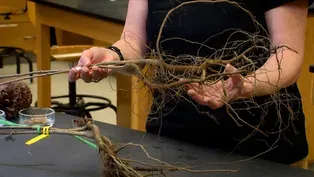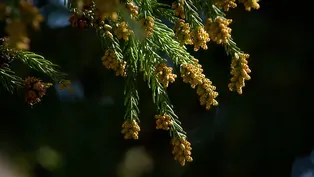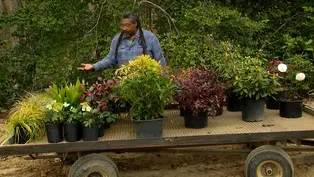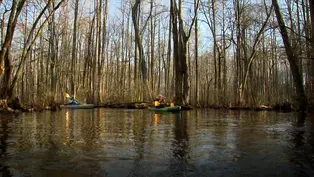Virginia Home Grown
Tree Climbing Vines
Clip: Season 25 Episode 1 | 5m 20sVideo has Closed Captions
Learn the differences in native and invasive vines
Greta Hoyt from Manchester Gardening visits Peggy Singlemann in the studio to explain why some vines are harmful if they are left to climb trees. Featured on VHG episode 2501, March 2025.
Problems with Closed Captions? Closed Captioning Feedback
Problems with Closed Captions? Closed Captioning Feedback
Virginia Home Grown is a local public television program presented by VPM
Virginia Home Grown
Tree Climbing Vines
Clip: Season 25 Episode 1 | 5m 20sVideo has Closed Captions
Greta Hoyt from Manchester Gardening visits Peggy Singlemann in the studio to explain why some vines are harmful if they are left to climb trees. Featured on VHG episode 2501, March 2025.
Problems with Closed Captions? Closed Captioning Feedback
How to Watch Virginia Home Grown
Virginia Home Grown is available to stream on pbs.org and the free PBS App, available on iPhone, Apple TV, Android TV, Android smartphones, Amazon Fire TV, Amazon Fire Tablet, Roku, Samsung Smart TV, and Vizio.
Providing Support for PBS.org
Learn Moreabout PBS online sponsorshipWell, Greta, you've got a lot of sticks and stuff here.
(laughs) >>I do.
But I want to first talk about how can these vines climb up trees?
>>Yes, and these big old trees that we have.
>>These big old trees.
And what makes it possible is all of these nicks and crannies that they can sink their tendrils and suckers and roots into.
So, if you can see these examples show that it makes it easy for them to climb up.
>>Yes.
They have things to hold onto.
>>So, things to hold onto.
We have English ivy and poison ivy here.
And I wanted to bring this to the attention because a lot of people get them confused for number of different reasons.
But one of the big reasons, English ivy is evergreen.
So, you can see that.
They're in the trees now all over, you know, the James River.
>>Highly invasive.
>>Highly invasive.
And then poison ivy are native, which has dense, matted roots that are much darker than the kind of scat- yeah, short little nubby roots of the English ivy.
This is harder to get off trees.
I mean, they're both hard to get off trees, but this is much easier to get off trees.
>>Yes.
And when that, sorry, when that poison ivy gets really large, it becomes a mass of roots.
Very, very fuzzy.
So it's easy to ID that, >>Yeah.
All the way, fuzzy all the way around.
Whereas English ivy, it's really kind of fuzzy kind of on the bottom of them.
So, for English ivy, when people are trying to get rid of that, we like to cut, you know, a foot or two foot between the trunk and the base of the ground.
And then once it falls off the tree, it kind of gives you this kind of neat little architectural like look.
And it does not have any roots on it.
So, this is English ivy, not poison ivy.
>>Yes, definitely.
Kind of architectural.
>>I think so.
>>Yeah.
Make a nice art project.
But what's one of your favorite vines?
>>One of my favorites is crossvine.
I just love the fall and winter color because it keeps its leaves during the winter, and it gives us these beautiful orange tubular flowers that hummingbirds love in the spring.
>>Yeah.
>>It can be a little aggressive, but it's one of our natives that is beautiful.
>>It is.
I grow it on a fence at my house and I love it.
>>I love it too.
>>And I've grown it, you know, for years at other places too.
So, but then there's this one, this is a very well known one.
>>Yes.
This is our Virginia creeper.
And this little guy grows with tendrils but has like a little sucking disc on it that allows it to really easily grab onto any surfaces, like houses or anything, really.
(chuckles) >>Really anything.
>>Yeah.
Because it can grow on the ground as ground cover and it gives you a beautiful fall color.
So in addition to the beautiful fall color of the poison ivy, we have the beautiful fall color of the Virginia creeper.
>>Virginia creeper.
You know, this one here, a lot of people are saying, you know, we should, you know, use a little more because many of our pollinators love the flower of this plant.
And our birds enjoy the seed as well.
So this and the, you know, crossvine, our Bignonia, are good plants to have.
>>Yeah.
We should use more.
>>In the right spot.
>>Yeah, yeah.
As long as we can kind of keep them under control.
>>Yes.
But this one prunes well.
>>Yes.
>>Very, very well.
So you've got some other ones here.
And this one here, you know, what I really like is the difference in the textures.
And here it is winter time, and we're talking about different vines because vine ID is so tough in the winter time.
It's much easier to ID plants with the leaves.
>>When they're in flower.
>>Yes.
>>Yes, of course they are.
>>But here you've got some characteristics of these two vines that will help you identify them.
>>Yep.
This is our native coral honeysuckle.
As you can see, it's got like striations in the bark.
But this guy is climbing hydrangea, and it's got nice little flaky bark, kind of like river birch, that gives you really interesting winter interest.
It blooms in the summer, kind of like a lace cap hydrangea bloom, almost.
>>It's very pretty.
>>It is very pretty.
And it can grow on trees, much like the form of poison ivy, where it kind of grows up and then kind of sends shoots out like that.
So it looks very similar in that fashion, too.
>>And I find it can grow in shade very well, but it takes a little while longer to bloom.
It has to become established.
>>Yeah.
Well, it takes a long time for it to become established as well.
>>It's a slow grower.
>>It's a slow grower for sure.
>>Unlike the honeysuckle one.
>>Yes.
Where the honeysuckle will grow, I don't know, probably 20 feet in a year, in a season, but give you some beautiful spring and summer blooms for all those little hummingbirds and little pollinators.
>>All those fun little things.
And there's different cultivars that you can buy with different color flowers.
>>Yep, yellow and pink and, yep.
>>It's a favorite of mine.
(chuckles) >>It is for me too.
And I like it when it grows together with roses.
I think that's really fun.
>>Very attractive, which, you know, we need to think about, we're talking here about vines on trees, but many other uses for them as well.
>>Sure.
To provide portals into the next garden space, you know, to make that exciting entryway, you know, transition, that I really like to incorporate into designs.
>>And as a landscape designer, yes, you would.
So, Greta, thank you.
>>Thank you, Peggy.
>>Thank you so much.
Video has Closed Captions
Learn the correct root to shoot ratio for planting new trees (3m 17s)
Video has Closed Captions
Learn how champion trees are measured and the special care they receive (8m 11s)
Video has Closed Captions
Learn about the many types of life recently discovered inside of trees (6m 42s)
Video has Closed Captions
Explore shrubs and groundcovers that grow well under big trees (3m 11s)
Video has Closed Captions
Explore the Dragon Run watershed, one of Virginia’s most pristine natural sites (8m 4s)
Providing Support for PBS.org
Learn Moreabout PBS online sponsorshipVirginia Home Grown is a local public television program presented by VPM
















